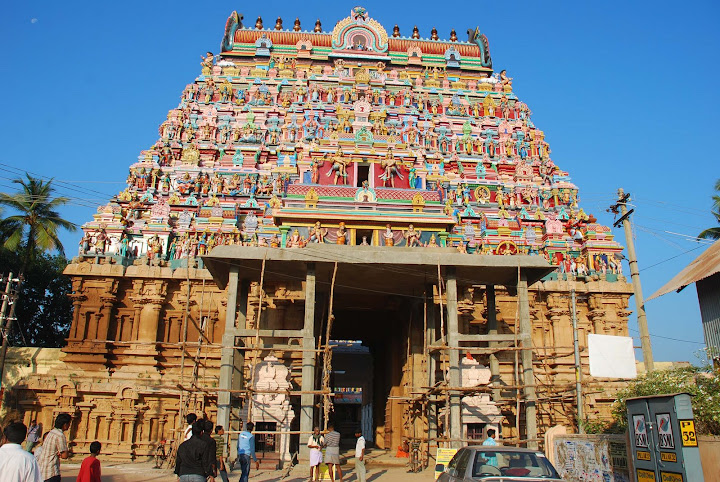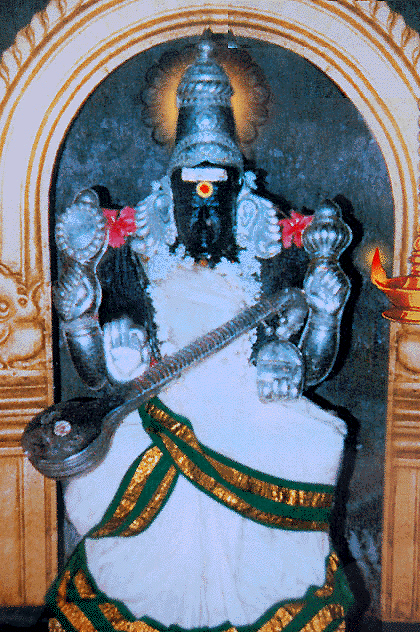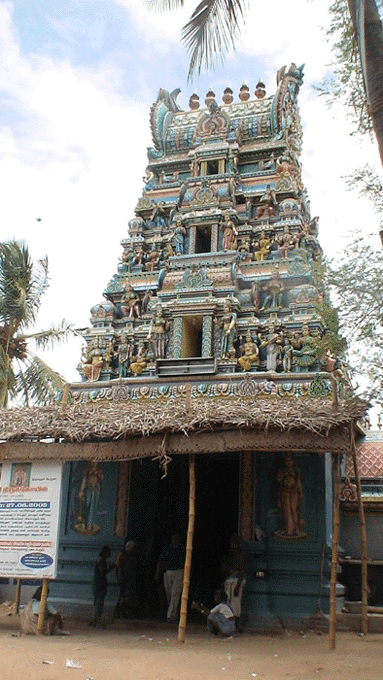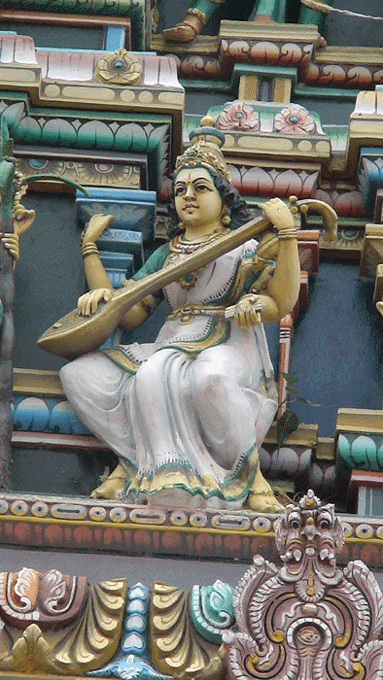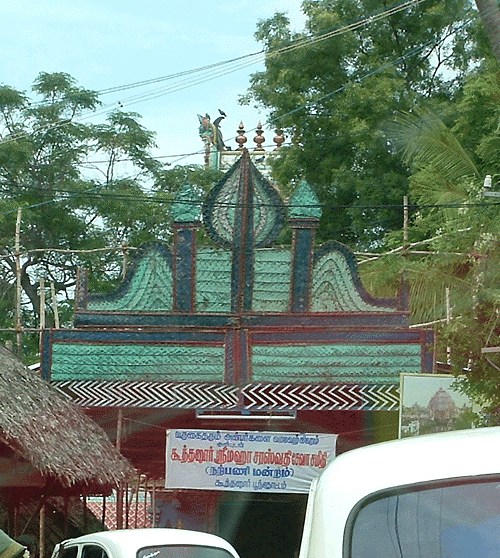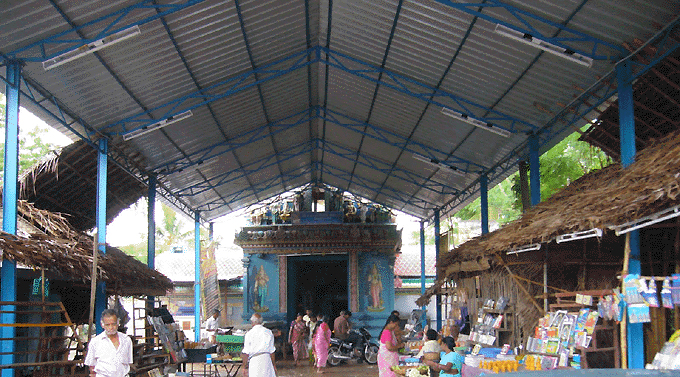About Temple:
Goddess Garbharakshambika is one of the most popular form of shakti in Tamilnadu.She is the lovely embodiment of womanhood and in this avatar as Garbharakshambika she has been ever gracious upon all womanhood to be the Goddess responsible to take care of women with uterus related disorders and pregnancy.
Godess Garbharakshambikai ,Thirukarugavur
Temple address and contact number
The Executive Officer
Arulmigu Mullai Vananathar Thirukovil
Thirukkarugavur (P.O)
Papanasam Tk.
Thanjavur Dt.
Tamil Nadu 614 302
Phone number : 04374 273423
Mobile number :08870058269
Thirukkarugavur Mullaivananathar Sri Garbharakshaambigai temple
The fame of this temple rests largely upon the Goddess Shri Garbharakshambika (an avatar of Goddess Parvati) who offers protection to, the human embryo. And it is no wonder that this temple draws worshippers from all sects.
The uniform experience of the people of these parts bears unfailing testimony to the said characteristic attributed to the Deity. The inhabitants of the village speak to the fact, that within Irving memory, there has been no case of fatality to the mother or child during confinement.
Pregnant women from elsewhere come here and pray to the God and Goddess for a safe child birth. No one in this place has ever had a miscarriage or pregnancy problem.
The Shri Garbharakshambika Sameta Shri Mullaivana Nathar temple is spread over a wide expanse with huge towering Gopurams and a beautiful water tank in front of it. The temple is surrounded by tall coconut – palms, the whole atmosphere is very calming and serene and lends the place sanctity.
About Temple:
Once you walk past the temple tank, you reach into the temple complex of Shri Garbharakshambika Sameta Shri Mullaivana Nathar.There is a main Raja gopuram on the east and the temple has also got an entrance on the south side.Both the shrines of Lord Mullaivana Nathar and Goddess Garbharakshambika are situated in the outer Prakaram, which is the main Prakaram facing the east direction.
The main sanctum of this temple has the Shiva lingam and Goddess Garbharakshambika is situated to the left of the Shiva temple. It is believed that the Nandi *at this temple is in Swayambhu vigraham (Self manifested) and so is the Karpaga Vinayagar inside the temple which is also a Swayambhu (self manifested) and as such commands unique devotion from the worshipers.
There is also a shrine for Lord Subramanian.(*The sacred bull on which Lord Shiva rides)Devotees pay their respects to the presiding deity, Shri Mullaivana nathar ( Lord Shiva) first, as is the custom that is followed in Shiva temples anywhere in TN and then to Goddess Garbharakshambika.
For Early Marriage:
The brides have to clean foot -steps of ambal sannathi with ghee and (beautifying the floor with kolams)
For Pregnancy:
Those who are not having children have to do the above in addition to intake the ghee with her spouse for 48 days before going to bed.
Method of Using The Blesssed Ghee:
The couple those are required to be blessed with a child has to intake the ghee(that is given as prasatham from the feet of Godess Garbharakshaambigai) by mixing the same with required amount of pure Cow -ghee for 48 days before going to bed.(Even if the husband is not in a position to intake the ghee at times , the wife has to intake the ghee continuously for 48 days days ) This does not have any restrictions or any barriers.
Those who take some other medicines also continue while they are in course of taking this ghee.Ladies during menstruation should not take the ghee for 5 days.if this is followed piously,the godess Garbharakshaambigai would bless them with a child.
Manthra or Prathana Slogas for Early Marriages And Pregnancy:
Ohm devendhirani Namasdubyam
Devendra Priya Bamini
Vivaha Bhaghyam ,Aroghyam
Puthra Labam Sathehimey
Bathim Dhehi ,Sudham Dhehi
Soubaghyam Dhehimey Subey
Sowmangalyam Subham Gnanam
Dheimey karbaratchake
Kathyaini mahamaye
Maha Yoghinya Dheeswari
Nandhagopa Sudham Dhevam
Bathim Meygurudhey Nama
For Easy Delivery:
To get easy delivery ,the caster oil,enriched by performing poojas at the feet of goddess Garbharakshaambigai,could be applied on the abodmen of the pregnant ladies,to make it easy delivery.
Method of Using Manthra Charged Castrol Oil:
The castrol might be applied on the lower abdomen of the pregnant lady at the time of delivery.Like that the same may be done if she gets pains at times ,during the period of pregnancy.
Prathana Sloga For Easy (Normal)Delivery:
Hey ,Shankara Smarahara Brahmadhathi
Nathari Mannatha Samba Sasisooda
Harathirisoolin sambo sugaprasava,Grighbavamey Dayalo,
Hey Madhavi Vanesa Palaiyamam Namasthey
This Sloga Has To Be Recited For 108 Times ,For Difficult – Free Deliveries:
Himavadh Yudhdharey Parchway Suratha Nama Yakshini
Dasya ,Smarana Madhrena Visalya Kabinibavedhu
People in whose case marriages are often held up and married people who have no children for a long time are blessed by the Goddess here. As a result of their worship and prayer, marriages take place, Children are born to the childless, Pregnancies are protected form all dangers and easy deliveries occur.
SMEARING OF THE STEPS WITH GHEE FOR FIXATION OF MARRIAGES
Virgins whose marriages are delayed for long periods and married women who have no issue for a long time should come to this Temple in person, wash the steps with a little ghee draw ‘ Kolam and perform Archana to the Goddess. If done so, their marriages will take place and the childless women will be blessed with children.
Manthra – Charged Ghee To Be Blessed With Children:
Couples who remain childless for a long time should offer ghee which will be placed at the Feet of the Goddess, charged with manthras and given to them. If the couples eat a little of this Ghee at night daily for 48 days the women will certainly conceive soon an they will be blessed with children.
Manthra Charging Of Castor Oil For Easy (Normal)Deliveries:
Pregnant women expection deliveries should offer castor oil which will be placed and Feet of Sri Garbha Rakshambikai, charged with manthras and offered to them. This castor oil has wonderful property. When the women get labour pains, this oil should be smeared on their abdomen. This will eliminate all complications, dangers and after effect of delivers and make the deliveries quite easy.
How to Reach Thirukarugavur Temple:
Thirukarugavur is in Papanasam taluka which is located on Thanjavur (Tanjore) - Kumbakonam road.
It can be reached from both Thanjavur and Kumbakonam. Town buses are available from both places to take you to the temple.
Papanasam is about 20 kilometers east of Thanjavur Town and at 20 kilometers South west of Kumbakonam, so the distance is almost the same.
Pilgrims coming form Madurai, Tiruchi, Coimbatore Salem etc., have to alight at Thanjavur Bus Stand and form there, they can come here by the Town Bus Number 24, 34, 16, 44 or by the route bus to Kumbakonam Via Melattur.
Pilgrims form Madras, Neyveli, Mayiladuthurai, Thiruvarur etc., have to alight at Kumbakonam bus stand and form there. They can come here by Town Bus numbers 11 and 29 or by the route bus to Thanjavur via Avur and Melattur. The Temple is at short distance formt the Thirukkarugavur Bus stand (Bazaar Bus stop).













